

To study optics is to participate in “the long history of humanity’s struggle to control light” [1]. With nano-optics, the specific interest is in how light and matter work and interact at the nanoscale to produce colours and other optical effects. While current technologies have allowed scientists and engineers to understand, produce, and control the design of nano-optical materials in new ways, both nature and history are filled with examples of nano-structures that interact with light in colourful ways, often in the form of what appears to our eyes as iridescence. From butterflies and birds with shimmering wings and feathers, the structural colours produced through nano-optics are part of nature’s designs. Humans have for a long time integrated structural colour in their artefacts: though unaware of the scientific explanation, Romans already used nanoparticles. An example is the Lycurgus Cup, a glass cup from the 4th century that includes nano-sized bits of gold and silver resulting in glass whose colour shifts depending on how light shines on and through it. Centuries later, during the Scientific Revolution, Robert Boyle and Isaac Newton began to scientifically describe this type of colour produced through physical structures rather than pigments. And, as technologies like electron beam microscopes were developed, allowing us to “see” the nanoscale, we have come to more fully understand the mechanisms of both structural colour and nano-optics…
Light is the key to nano-optical colour, which is produced from the particular interactions between light and matter. The branch of physics that considers these effects, and more broadly the constitution, shape, and dynamics of light, is called optics. We currently understand light as a wave, or rather as the coupling of two waves, one resulting from the variation of an electric field and the other of the variation of a magnetic field. These waves can be analyzed and measured through different closely-related parameters: wavelength (the distance between two extrema), frequency (the number of cycles per unit time), speed (the movement in space per unit of time), and energy (electromagnetic). (Fig. 1)
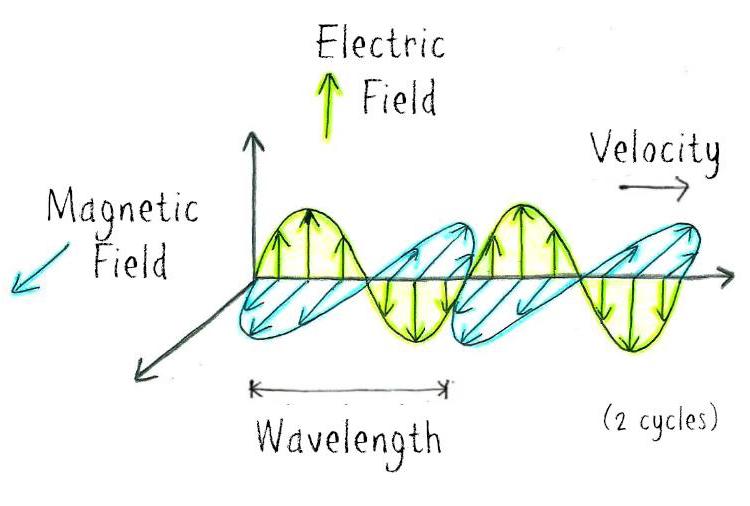
In its everyday use, light usually refers to visible light, but in the physical sense light comprises the entire spectrum of electromagnetic radiation, including radio waves or ultraviolet (UV) radiation, for example. (Fig. 2)
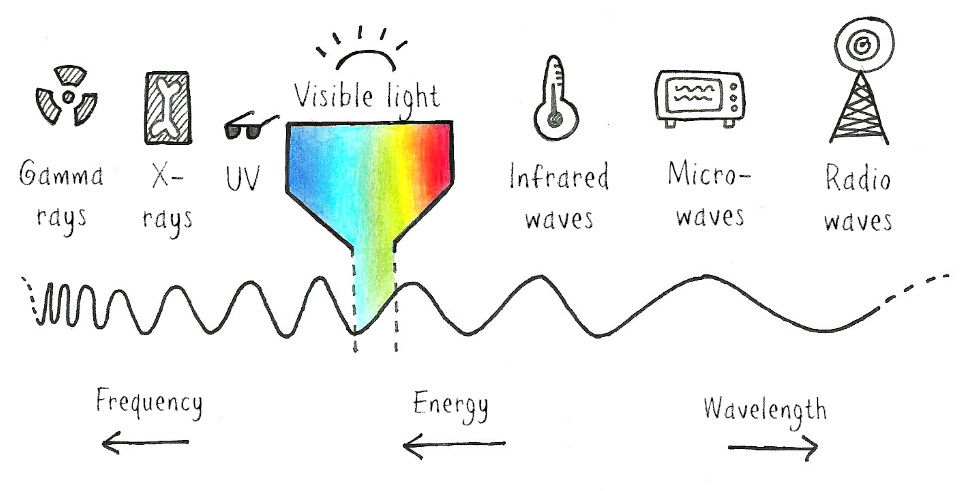
Light can be considered as oscillating electromagnetic waves comprised of a broad range of wavelengths. Human beings, through the biological photoreceptors in their eyes called “cones,” can see light with wavelengths between 400 nm and 700 nm (hence the qualification of visible to this region of the spectrum). Different wavelengths produce different perception of colours, for example, 445 nm wavelength for pure blue colour and 535 nm wavelength for pure green colour. (Fig. 3) The human eye can capture red, green, and blue (RGB), allowing us to see all possible combinations of these colours, and thus to perceive the world colourfully.

Light participates in a multitude of nanoscale interactions, which can be divided into two categories: the interaction of light with other light, and light’s interactions with matter. The undulatory character of light explains much of its behaviour. The meeting of two light beams can for instance be compared to the meeting between the waves produced following the disturbance of a lake with two stones thrown close to each other. Each stone then generates a wave around it, and the fluctuations thus generated meet and interfere constructively and destructively. (Fig. 4)
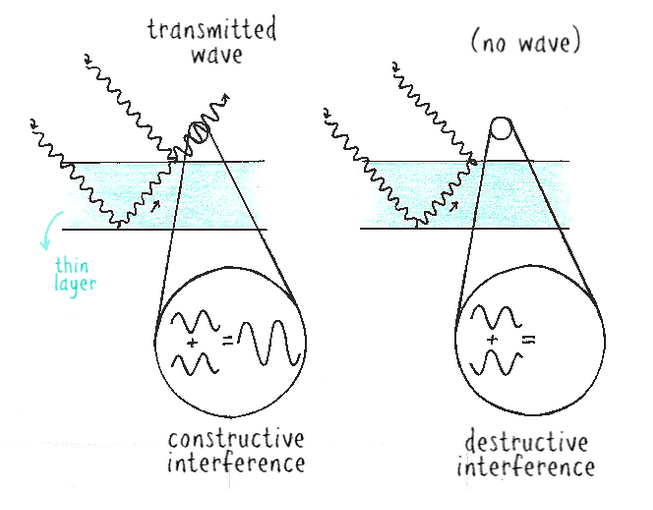
Matter can be considered as an obstacle in the trajectory of a light beam (which is made up of many light waves). Dependent on its chemical and physical properties, it can change the course of light in different ways. It can deflect the light more or less intensely while allowing it to pass through (refraction); absorb it completely or partially; or reflect it totally or partially. If a light beam encounters an obstacle or opening of an order of magnitude close to its wavelengths, light waves can also be diffracted, meaning that the beam is diffused in different directions according to the different wavelengths that compose it. (Fig. 5)
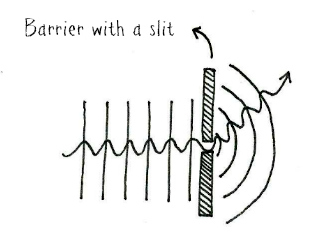
The colourful appearance of objects as we see them is the result of different combinations of these mechanisms of light-light and light-matter interaction. Pigment (or chemical) colour and structural (or physical) colour offer two different explanations for why we see the world in colour. In the case of pigmented matter, the light directed at an object (incident light) is partially absorbed by it, and the reflected portion is that captured by the eye. Thus, we see that a red apple is red because it absorbs the light rays of all wavelengths in the visible spectrum except red, which it reflects. This becomes what we see. (Fig. 6)
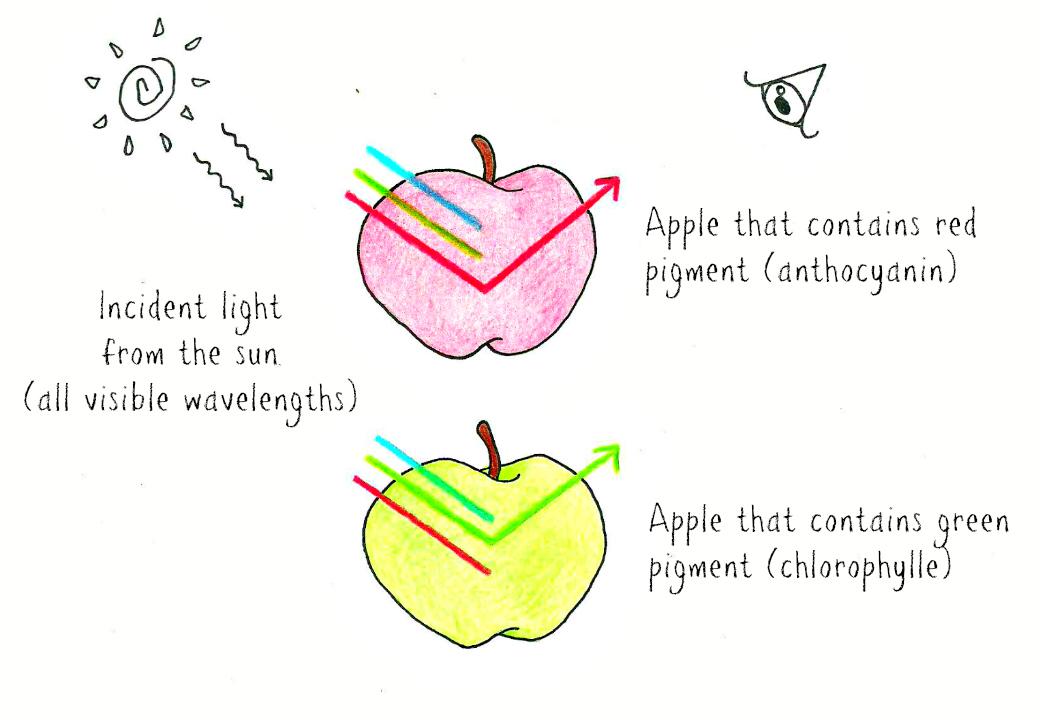
Unlike pigments, structural colour relies on an interaction of light with a physical structure containing nanoscale features comparable in size to the light wavelength. This type of colouration is based on pure physical phenomena such as diffraction, interference, or scattering. (Fig. 7) We see structural colour in everyday life, particularly in the phenomenon of iridescence…

Iridescence is an optical phenomenon based on the principles of structural colour. More precisely, an object is said to be iridescent if the colours fluctuate in movement. This can be caused either by the changing position of the observer, or the motion of the object, both of which change the angles of sight produced between the object and the human eye and thus resulting in varying perceptions of colour. (Fig. 8)

The natural world is filled with examples of iridescence, for example in insects and animals. The best known are probably the morpho butterfly, the hummingbird, and the peacock. While their iridescent wings and feathers have fascinated humans for centuries, it is only with the invention of the electron beam microscope in the 1930s that the phenomenon could finally be scientifically explained. (Fig. 9) Once such naturally-occurring iridescent effects were understood, scientists could strive to replicate and engineer materials with similar morphologies and effects. This imitation of nature is sometimes referred to as biomimetic engineering…

Hi. I'm popup. I contain additionnal information about this.
Hi. I'm popup. I contain additionnal information about this.
Hello. Welcome into Project Nanoverse. Nice to meet you!